Sony Ericsson T700 User Manual

Thank you for purchasing a Sony Ericsson T700. Communicate in style. Show who you are.
For additional phone content, go to www.sonyericsson.com/fun.
Register now to get a suite of tools, free online storage, special offers, news and competitions at www.sonyericsson.com/myphone.
For product support, go to www.sonyericsson.com/support.
This is the Internet version of the User guide. © Print only for private use.
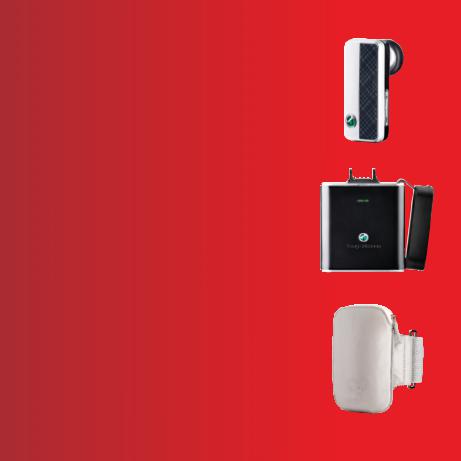
Accessories – More for your phone
Bluetooth™ Headset HBH-PV720
Sophisticated wireless headset for the fashion-conscious
Power Pack CPP-100
Convenient backup for when you are out of power
Exercise Case IDC-32
Carry and protect your phone while exercising
These accessories can be purchased separately but may not be available in
every market. To view the full range go to www.sonyericsson.com/accessories.
This is the Internet version of the User guide. © Print only for private use.
Contents
Getting started ................... |
5 |
Assembly ......................................... |
5 |
Turning on the phone ...................... |
6 |
Help ................................................. |
7 |
Charging the battery ........................ |
8 |
Phone overview ............................... |
9 |
Menu overview .............................. |
11 |
Navigation ..................................... |
13 |
Memory .......................................... |
14 |
Phone language ............................ |
15 |
Entering text .................................. |
15 |
Music ................................ |
17 |
Stereo portable handsfree ........... |
17 |
Music player .................................. |
17 |
PlayNow™ .................................... |
18 |
TrackID™ ....................................... |
19 |
Online music and video clips ........ |
19 |
Video player ................................... |
19 |
Radio ............................................ |
19 |
MusicDJ™ .................................... |
20 |
Record sound ............................... |
20 |
Transferring and handling |
|
content .............................. |
21 |
Handling content within the phone 21 Sending content to another phone 21
Transferring content to and from |
|
a computer ................................... |
22 |
Using the USB cable .................... |
23 |
Phone name .................................. |
24 |
Using Bluetooth™ wireless |
|
technology ..................................... |
24 |
Backing up and restoring .............. |
25 |
Calling .............................. |
27 |
Making and receiving calls ............ |
27 |
Contacts ....................................... |
29 |
Call list ........................................... |
32 |
Speed dial ...................................... |
32 |
Voicemail ....................................... |
32 |
Voice control ................................. |
33 |
More than one call ......................... |
34 |
Restricted dialling .......................... |
36 |
Call time and cost .......................... |
37 |
Showing or hiding your phone |
|
number ......................................... |
37 |
Messaging ........................ |
37 |
Text messages ............................... |
37 |
Picture messages .......................... |
38 |
Message options ........................... |
39 |
Templates ...................................... |
39 |
Voice messages ............................ |
40 |
Contents 1
This is the Internet version of the User guide. © Print only for private use.
Email ............................................. |
40 |
My friends ...................................... |
41 |
Area and cell information .............. |
43 |
Imaging ............................ |
43 |
Viewfinder and camera keys ......... |
43 |
Using the camera ........................... |
43 |
More camera features .................... |
44 |
Viewing and tagging pictures ........ |
44 |
Blogging ......................................... |
47 |
Printing photos .............................. |
47 |
Internet .............................. |
48 |
Bookmarks .................................... |
48 |
History pages ................................. |
48 |
More browser features ................... |
49 |
Internet security and certificates |
.. 50 |
Web feeds ..................................... |
50 |
Synchronizing .................. |
52 |
Synchronizing using a computer ... 52
Synchronizing using an Internet |
|
service ........................................... |
53 |
Calendar ....................................... |
57 |
Notes ............................................ |
58 |
Tasks ............................................ |
58 |
Profiles ........................................... |
59 |
Time and date ............................... |
59 |
Theme ........................................... |
59 |
Main menu layout .......................... |
59 |
Ringtones ...................................... |
60 |
Screen orientation ......................... |
60 |
Games .......................................... |
60 |
Applications .................................. |
60 |
Locks ............................................. |
61 |
Troubleshooting ............... |
63 |
Common questions ....................... |
63 |
Error messages .............................. |
66 |
Important information ...... |
67 |
Guidelines for Safe and |
|
Efficient Use .................................. |
69 |
Limited Warranty ........................... |
73 |
FCC Statement .............................. |
75 |
Declaration of Conformity for T700 .. |
76 |
More features ................... |
54 |
Index ................................. |
77 |
Flight mode ................................... |
54 |
|
|
Update service .............................. |
54 |
|
|
Location services ........................... |
55 |
|
|
Alarms ........................................... |
56 |
|
|
2Contents
This is the Internet version of the User guide. © Print only for private use.
Sony Ericsson T700
UMTS HSDPA 2100 GSM EDGE 850/900/1800/1900 This User guide is published by Sony Ericsson Mobile Communications AB or its local affiliated company, without any warranty. Improvements and changes to this User guide necessitated by typographical errors, inaccuracies of current information, or improvements to programs and/or equipment, may be made by Sony Ericsson Mobile Communications AB at any time and without notice. Such changes will, however, be incorporated into new editions of this User guide.
All rights reserved.
©Sony Ericsson Mobile Communications AB, 2008 Publication number: 1214-6961.1
Please note:
Some of the services in this User guide are not supported by all networks. This also applies to the GSM International Emergency Number 112. Please contact your network operator or service provider if you are in doubt whether you can use a particular service or not.
Please read the Important information chapters before you use your mobile phone.
Your mobile phone has the capability to download, store and forward additional content, e.g. ringtones. The use of such content may be restricted or prohibited by rights of third parties, including but not limited to restriction under applicable copyright laws. You, and not Sony Ericsson, are entirely responsible for additional content that you download to or forward from your mobile phone. Prior to your use of any additional content, please verify that your intended use is properly licensed or is otherwise authorized. Sony Ericsson does not guarantee the accuracy, integrity or quality of any additional content or any other third party content. Under no circumstances will Sony Ericsson be liable in any way for your improper use of additional content or other third party content.
Smart-Fit Rendering is a trademark or a registered trademark of ACCESS Co., Ltd.
Bluetooth is a trademark or a registered trademark of Bluetooth SIG Inc. and any use of such mark by Sony Ericsson is under license.
The Liquid Identity logo, SensMe, PlayNow, MusicDJ, PhotoDJ, TrackID and VideoDJ are trademarks or registered trademarks of Sony Ericsson Mobile Communications AB.
TrackID™ is powered by Gracenote Mobile MusicID™. Gracenote and Gracenote Mobile MusicID are trademarks or registered trademarks of Gracenote, Inc.
Lotus Notes is a trademark or a registered trademark of International Business Machines Corporation. Sony, Memory Stick Micro™ and M2™ are trademarks or registered trademarks of Sony Corporation.
Google™ and Google Maps™ are trademarks or registered trademarks of Google, Inc.
SyncML is a trademark or registered trademark of Open Mobile Alliance LTD.
Ericsson is a trademark or registered trademark of Telefonaktiebolaget LM Ericsson.
Adobe Photoshop Album Starter Edition is a trademark or registered trademark of Adobe Systems Incorporated in the United States and/or other countries.
Microsoft, ActiveSync, Windows, Outlook, and Vista are registered trademarks or trademarks of Microsoft Corporation in the United States and/or other countries.
T9™ Text Input is a trademark or a registered trademark of Tegic Communications. T9™ Text Input is licensed under one or more of the following: U.S. Pat. Nos. 5,818,437, 5,953,541, 5,187,480, 5,945,928, and 6,011,554; Canadian Pat. No. 1,331,057, United Kingdom Pat. No. 2238414B; Hong Kong Standard Pat. No. HK0940329; Republic of Singapore Pat. No. 51383;
3
This is the Internet version of the User guide. © Print only for private use.
Euro.Pat. No. 0 842 463(96927260.8) DE/DK, FI, FR, IT, NL, PT, ES, SE, GB; and additional patents are pending worldwide.
This product is protected by certain intellectual property rights of Microsoft. Use or distribution of such technology outside of this product is prohibited without a license from Microsoft. Content owners use Windows Media digital rights
management technology (WMDRM) to protect their intellectual property, including copyrights. This device uses WMDRM software to access WMDRMprotected content. If the WMDRM software fails to protect the content, content owners may ask Microsoft to revoke the software's ability to use WMDRM to play or copy protected content. Revocation does not affect unprotected content. When you download licenses for protected content, you agree that Microsoft may include a revocation list with the licenses. Content owners may require you to upgrade WMDRM to access their content. If you decline an upgrade, you will not be able to access content that requires the upgrade. This product is licensed under the MPEG-4 visual and AVC patent portfolio licenses for the personal and non-commercial use of a consumer for (i) encoding video in compliance with the MPEG-4 visual standard ("MPEG-4 video") or the AVC standard ("AVC video") and/or (ii) decoding MPEG-4 or AVC video that was encoded by a consumer engaged in a personal and non-commercial activity and/or was obtained from a video provider licensed by MPEG LA to provide MPEG-4 and/or AVC video. No license is granted or shall be implied for any other use. Additional information including that relating to promotional, internal and commercial uses and licensing may be obtained from MPEG LA, L.L.C. See http://www.mpegla.com. MPEG Layer-3 audio decoding technology licensed from Fraunhofer IIS and Thomson.
Java, JavaScript and Java-based trademarks and logos are trademarks or registered trademarks of Sun Microsystems, Inc., in the U.S. and other countries. End-user license agreement for Sun Java Platform, Micro Edition. 1. Restrictions: Software is confidential copyrighted information of Sun and title to all copies is retained by Sun and/or its licensors. Customer shall not modify, decompile, disassemble, decrypt, extract, or otherwise reverse engineer Software. Software may not be leased, assigned, or sublicensed, in whole or in part.
2.Export Regulations: Software including technical data, is subject to U.S. export control laws, including the U.S. Export Administration Act and its associated regulations, and may be subject to export or import regulations in other countries. Customer agrees to comply strictly with all such regulations and acknowledges that it has the responsibility to obtain licenses to export, reexport, or import Software. Software may not be downloaded, or otherwise exported or re-exported
(i) into, or to a national or resident of, Cuba, Iraq, Iran, North Korea, Libya, Sudan, Syria (as such listing may be revised from time to time) or any country to which the U.S. has embargoed goods; or (ii) to anyone on the U.S. Treasury Department's list of Specially Designated Nations or the U.S. Commerce Department's Table of Denial Orders.
3.Restricted Rights: Use, duplication or disclosure by the United States government is subject to the restrictions as set forth in the Rights in Technical Data and Computer Software Clauses in DFARS 252.227-7013(c) (1) and FAR 52.227-19(c) (2) as applicable.
Other product and company names mentioned herein may be the trademarks of their respective owners.
Any rights not expressly granted herein are reserved. All illustrations are for illustration only and may not accurately depict the actual phone.
4
This is the Internet version of the User guide. © Print only for private use.
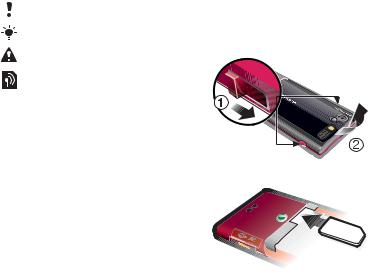
Instruction symbols
These symbols may appear in the User guide.
Note
Tip
Warning
A service or function is networkor subscription-dependent. Contact your network operator for details.
>Use a selection or navigation key to scroll and select. See
Navigation on page 13.
Getting started
Assembly
Before you start using your phone, you need to insert a SIM card and the battery.
To insert the SIM card
1 Unlock and remove the battery cover.
2Slide the SIM card into its holder with the gold-coloured contacts facing down.
Getting started |
5 |
This is the Internet version of the User guide. © Print only for private use.
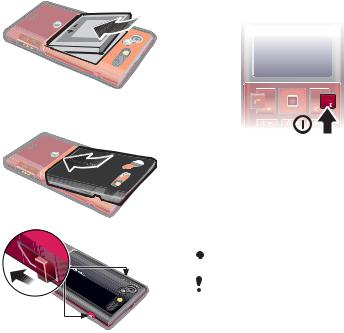
To insert the battery |
Turning on the phone |
||
|
To turn on the phone |
||
|
|
|
|
|
|
|
|
|
|
|
|
1Insert the battery with the label side up and the connectors facing each other.
2Slide the battery cover into place and lock it.
1 Press and hold down  .
.
2Enter your SIM card PIN, if requested and select OK.
3 Select a language.
4Select Cont. to use the setup wizard while Internet and picture message settings are downloaded.
 To correct a mistake when you enter
To correct a mistake when you enter  your PIN, press
your PIN, press  .
.
Before turning the phone off, you must return to standby.
6Getting started
This is the Internet version of the User guide. © Print only for private use.

SIM card
The SIM (Subscriber Identity Module) card, which you get from your network operator, contains information about your subscription. Always turn off your phone and detach the charger before you insert or remove the SIM card.
Standby
After you have turned on your phone and entered your PIN, the name of the network operator appears. This view is called standby. Your phone is now ready for use.
 You can save contacts on the SIM card
You can save contacts on the SIM card  before you remove it from your phone. See To copy names and numbers to the SIM card on page 30.
before you remove it from your phone. See To copy names and numbers to the SIM card on page 30.
PIN
You may need a PIN (Personal Identification Number) to activate the services and functions in your phone. Your PIN is supplied by your network operator. Each PIN digit appears as *, unless it starts with emergency number digits, for example, 112 or 911. You can see and call an emergency number without entering a PIN.
If you enter the wrong PIN three times in a row, the SIM card is blocked. See SIM card lock on page 61.
Help
In addition to this User guide, Getting started guides and more information are available at www.sonyericsson.com/support.
Help and information are also available in your phone.
To view tips and tricks
1From standby select Menu > Settings
> the General tab > Setup wizard.
2 Select Tips and tricks.
To view information about functions
•Scroll to a function and select Options.
To view the phone demonstration
•From standby select Menu >
Entertainment > Demo tour.
To view the phone status
•From standby press the volume key up. Phone, memory and battery information is shown.
Getting started |
7 |
This is the Internet version of the User guide. © Print only for private use.
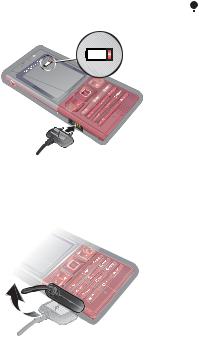
Charging the battery
The phone battery is partly charged when you buy it.
To charge the battery
1Connect the charger to the phone. It takes approximately 2.5 hours to fully charge the battery. Press a key to view the screen.
2Remove the charger by tilting the plug upwards.
 You can use your phone while it is
You can use your phone while it is
charging. You can charge the battery at any time and for more or less than
2.5 hours. You can interrupt the charging without damaging the battery.
8Getting started
This is the Internet version of the User guide. © Print only for private use.

Phone overview
1Ear speaker
2Screen
3Selection keys
4Call key
5Activity menu key
6Selection key
7Keylock key
8Microphone
9Silent key
10Camera key
11C key (Clear)
12End key, On/off key
13Volume, camera zoom keys
14Battery cover lock
|
14 |
1 |
|
|
13 |
2 |
|
3 |
12 |
4 |
11 |
10 |
|
5 |
|
6 |
|
|
9 |
7 |
|
8
Getting started |
9 |
This is the Internet version of the User guide. © Print only for private use.
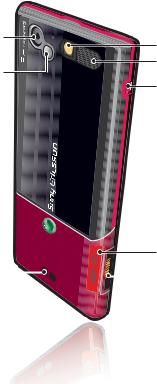
15Camera lens
16Self-portrait mirror
17Strap holder
18Connector for charger, handsfree and USB cable
19Memory card slot
20Battery cover lock
21Speaker
22Photo light, torch, video indicator light
15 |
22 |
|
|
||
16 |
21 |
|
20 |
||
|
19
17 |
|
|
|
18 |
|
||||
|
|
10 Getting started
This is the Internet version of the User guide. © Print only for private use.
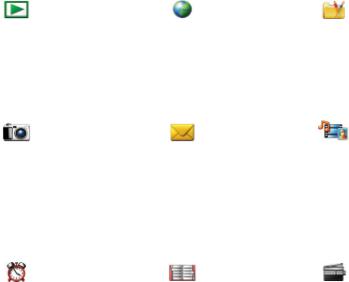
Menu overview
PlayNow™* |
Internet* |
Entertainme |
|
|
nt |
Online services*
TrackID™
Location services
Games
VideoDJ™
PhotoDJ™
MusicDJ™
Remote control
Record sound
Demo tour
Camera |
Messaging |
Media |
|
Write new |
Photo |
|
Inbox |
Music |
|
Video |
|
|
Drafts |
Games |
|
Outbox |
TV |
|
Sent messages |
Web feeds |
|
Saved messages |
Settings |
|
My friends* |
|
|
Call voicemail |
|
|
Templates |
|
|
Manage messages |
|
|
Settings |
|
Alarms |
Contacts |
Radio |
|
Myself |
|
|
New contact |
|
Getting started |
11 |
This is the Internet version of the User guide. © Print only for private use.

Calls** |
|
|
|
Organizer |
|
|
|
|
|
File manager** |
|
All |
Answered |
Dialled |
Missed |
Applications |
|
Video call |
|||||
|
|
|
|
||
|
|
|
|
Calendar |
|
|
|
|
|
Tasks |
|
|
|
|
|
Notes |
|
|
|
|
|
Synchronization |
|
|
|
|
|
Timer |
|
|
|
|
|
Stopwatch |
|
|
|
|
|
Light |
|
|
|
|
|
Calculator |
|
|
|
|
|
Code memo |
|
Settings** |
|
|
|
|
|
General |
Sounds & alerts |
Display |
Calls |
Connectivity |
|
Profiles |
Ring volume |
Wallpaper |
Speed dial |
Bluetooth |
|
Time & date |
Ringtone |
Main menu layout |
Smart search |
USB |
|
Language |
Silent mode |
Theme |
Divert calls |
Phone name |
|
Update service |
Increasing ring |
Startup screen |
Switch to line 2* |
Network sharing |
|
Voice control |
Vibrating alert |
Screen saver |
Manage calls |
Synchronization |
|
New events |
Message alert |
Clock size |
Time & cost* |
Device management |
|
Shortcuts |
Key sound |
Brightness |
Show/hide my no. |
Mobile networks |
|
Flight mode |
|
Edit line names* |
Handsfree |
Data communication* |
|
Security |
|
|
|
Internet settings |
|
Setup wizard |
|
|
|
Streaming settings |
|
Accessibility* |
|
|
|
Message settings* |
|
Phone status |
|
|
|
SIP settings |
|
Master reset |
|
|
|
Accessories |
* Some menus are operator-, networkand subscription-dependent.
** You can use the navigation key to scroll between tabs in submenus. For more information, see Navigation on page 13.
12 Getting started
This is the Internet version of the User guide. © Print only for private use.
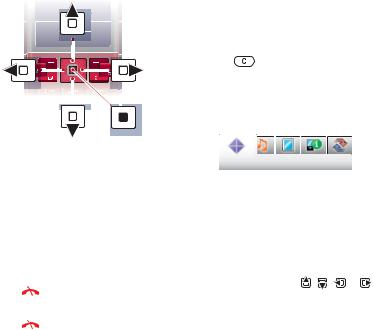
|
Navigation |
|
To navigate your media |
|
|||||||||||||||||||||||
|
To navigate the phone menus |
1 From standby select Menu > Media. |
|
||||||||||||||||||||||||
|
2 Scroll to a menu item and press the |
|
|||||||||||||||||||||||||
|
|
|
|
|
|
|
|
|
|
|
|
|
|
|
|
|
|
|
|
|
|
|
|
||||
|
|
|
|
|
|
|
|
|
|
|
|
|
|
|
|
|
|
|
|
|
|
|
|
navigation key right. |
|
||
|
|
|
|
|
|
|
|
|
|
|
|
|
|
|
|
|
|
|
|
|
|
|
|
|
|||
|
|
|
|
|
|
|
|
|
|
|
|
|
|
|
|
|
|
|
|
|
|
|
3 To go back, press the navigation |
|
|||
|
|
|
|
|
|
|
|
|
|
|
|
|
|
|
|
|
|
|
|
|
|
|
|
key left. |
|
|
|
|
|
|
|
|
|
|
|
|
|
|
|
|
|
|
|
|
|
|
|
|
|
|
|
To delete items |
|
||
|
|
|
|
|
|
|
|
|
|
|
|
|
|
|
|
|
|
|
|
|
|
|
|
|
|||
|
|
|
|
|
|
|
|
|
|
|
|
|
|
|
|
|
|
|
|
|
|
|
• |
Press |
to delete items such as |
|
|
|
|
|
|
|
|
|
|
|
|
|
|
|
|
|
|
|
|
|
|
|
|
|
|
||||
|
|
|
|
|
|
|
|
|
|
|
|
|
|
|
|
|
|
|
|
|
|
|
|
||||
|
|
|
|
|
|
|
|
|
|
|
|
|
|
|
|
|
|
|
|
|
|
|
|
numbers, letters, pictures and sounds. |
|||
|
|
|
|
|
|
|
|
|
|
|
|
|
|
|
|
|
|
|
|
|
|
|
|
||||
|
|
|
|
|
|
|
|
|
|
|
|
|
|
|
|
|
|
|
|
|
|
|
|
||||
|
|
|
|
|
|
|
|
|
|
|
|
|
|
|
|
|
|
|
|
|
|
|
|
Tabs |
|
|
|
|
|
|
|
|
|
|
|
|
|
|
|
|
|
|
|
|
|
|
|
|
|
|
|
|
|
||
|
|
|
|
|
|
|
|
|
|
|
|
|
|
|
|
|
|
|
|
|
|
|
|
|
|
||
|
|
|
|
|
|
|
|
|
|
|
|
|
|
|
|
|
|
|
|
|
|
|
|
|
|
||
|
|
|
|
|
|
|
|
|
|
|
|
|
|
|
|
|
|
|
|
|
|
|
|
|
|
||
|
|
|
|
|
|
|
|
|
|
|
|
|
|
|
|
|
|
|
|
|
|
|
|
Tabs may be available. For example, |
|||
|
|
|
|
|
|
|
|
|
|
|
|
|
|
|
|
|
|
|
|
|
|
|
|
||||
|
|
|
|
|
|
|
|
|
|
|
|
|
|
|
|
|
|
|
|
|
|
|
|
||||
|
|
|
|
|
|
|
|
|
|
|
|
|
|
|
|
|
|
|
|
|
|
|
|
Settings have tabs. |
|
||
|
|
|
|
|
|
|
|
|
|
|
|
|
|
|
|||||||||||||
|
|
|
|
|
|
|
|
|
|
|
|
|
|
|
|
|
|
|
|
|
|
|
|
|
|
|
|
1 From standby select Menu. |
|
|
|
|
|||||||||||||||||||||||
2 Use the navigation key to move through |
|
|
|
|
|||||||||||||||||||||||
|
the menus. |
|
|
|
|
||||||||||||||||||||||
|
To select actions on the screen |
|
To scroll between tabs |
|
|||||||||||||||||||||||
|
• |
Press the navigation key left or right. |
|||||||||||||||||||||||||
• |
Press the left, centre or right selection |
||||||||||||||||||||||||||
|
|
|
|
||||||||||||||||||||||||
|
key. |
|
|
|
|
|
|
|
|
|
|
|
|
|
|
|
|
|
|
|
|
Shortcuts |
|
|
|||
|
To view options for an item |
|
You can use keypad shortcuts to go |
||||||||||||||||||||||||
|
|
directly to functions. |
|
||||||||||||||||||||||||
• |
Select Options to, for example, edit. |
|
|
||||||||||||||||||||||||
|
|
|
|
||||||||||||||||||||||||
|
To end a function |
|
To use navigation key shortcuts |
|
|||||||||||||||||||||||
|
• |
From standby press , , or |
to |
||||||||||||||||||||||||
• |
Press |
. |
|
|
|
|
|
|
|
|
|
|
|
|
|
|
|
|
|||||||||
|
|
|
|
|
|
|
|
|
|
|
|
|
|
|
|
|
go directly to a function. |
|
|||||||||
|
|
|
|
|
|
|
|
|
|
|
|
|
|
|
|
|
|
|
|
|
|
|
|
|
|||
|
To return to standby |
|
|
|
|
||||||||||||||||||||||
• |
Press |
. |
|
|
|
|
|
|
|
|
|
|
|
|
|
|
|
|
|
|
|
|
|||||
|
|
|
|
|
|
|
|
|
|
|
|
|
|
|
|
|
|
|
|
|
|
|
|
|
Getting started |
13 |
|
This is the Internet version of the User guide. © Print only for private use.

To edit a navigation key shortcut
1From standby select Menu > Settings
> the General tab > Shortcuts.
2 Scroll to an option and select Edit.
3Scroll to a menu option and select
Shortc.
Main menu shortcuts
Menu numbering starts from the top left icon and moves across and then down row by row.
To go directly to a main menu
•From standby select Menu and press
 –
–  ,
,  ,
,  or
or  .
.
The Main menu layout must be set to Grid. See To change the main menu layout on page 59.
Activity menu
The activity menu gives you quick access to:
•New events – missed calls and new messages.
•Running apps – applications that are running in the background.
•My shortcuts – add your favourite functions to access them quickly.
•Internet – quick access to the Internet.
To open the activity menu
• Press  .
.
Memory
You can save content on the memory card, in the phone memory and on the SIM card. Pictures and music are saved on the memory card if a memory card is inserted. If not, or if the memory card is full, they are saved in the phone memory. Messages and contacts are saved in the phone memory, but you can choose to save them on the SIM card.
Memory card
Your phone supports Memory Stick Micro™ (M2™) memory card adding more storage space to your phone. It can also be used as a portable memory card with other compatible devices.
You can move content between the memory card and the phone memory. See Handling content within the phone on page 21.
You may have to purchase a memory card separately.
14 Getting started
This is the Internet version of the User guide. © Print only for private use.

To insert a memory card
•Insert the memory card with the gold-coloured contacts facing down.
To remove a memory card
To view memory card options
1From standby select Menu > Organizer
> File manager > the On memory card tab.
2 Select Options.
Phone language
You can select a language to use in your phone.
To change the phone language
1From standby select Menu > Settings
> the General tab > Language > Phone language.
2 Select an option.
•Press the edge of the memory card to release and remove it.
Entering text
You can use multitap text input or T9™ Text Input  to enter text. The T9 Text Input method uses a built-in dictionary.
to enter text. The T9 Text Input method uses a built-in dictionary.
To change text input method
•When you enter text, press and hold down  .
.
To shift between capitals and lowercase letters
•When you enter text, press  .
.
To enter numbers
•When you enter text, press and hold down  –
–  .
.
Getting started |
15 |
This is the Internet version of the User guide. © Print only for private use.

To enter full stops and commas
• When you enter text, press  .
.
To enter a symbol
1When you enter text, select Options >
Add symbol.
2 Scroll to a symbol and select Insert.
To enter text using T9™ Text Input
1From standby select, for example,
Menu > Messaging > Write new > Text message.
2If  is not displayed, press and hold down
is not displayed, press and hold down  to change to T9 Text Input.
to change to T9 Text Input.
3Press each key only once, even if the letter you want is not the first letter on the key. For example, to write the word “Jane”, press  ,
,  ,
,  ,
,  . Write the whole word before looking at the suggestions.
. Write the whole word before looking at the suggestions.
4 |
Use or |
to view suggestions. |
5 |
Press |
to accept a suggestion. |
To enter text using multitap
1From standby select, for example,
Menu > Messaging > Write new > Text message.
2If is displayed, press and hold down
is displayed, press and hold down
 to change to multitap text input.
to change to multitap text input.
3 Press  –
–  repeatedly until the desired letter appears.
repeatedly until the desired letter appears.
4When a word is written, press  to add a space.
to add a space.
To add words to the built-in dictionary
1When you enter text using T9 Text Input, select Options > Spell word.
2Write the word using multitap input and select Insert.
16 Getting started
This is the Internet version of the User guide. © Print only for private use.
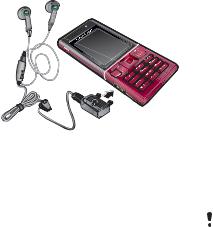
Music
You can listen to music, audio books and podcasts. Use Sony Ericsson Media Manager to transfer content to and from your phone. See Transferring content to and from a computer on page 22 for more information.
Stereo portable handsfree
To use the handsfree
•Connect the portable handsfree. Music stops when you receive a call and resumes when the call has ended.
2Browse by category using the navigation key.
3 Scroll to a track and select Play.
To stop playing music
•Press the centre navigation key.
To fast forward and rewind
•Press and hold down  or
or  .
.
To move between tracks
•Press  or
or  .
.
To minimize the player
•When music is playing, select Options
> Minimize.
To return to the player
•From standby select Menu > Media.
Playlists
You can create playlists to organize your music. Tracks can be added to more than one playlist.
Deleting a playlist, or a track from a playlist, does not delete the track from the memory, just the reference to the track.
Music player |
It may take a few minutes for the phone |
|
|
To play music |
to create a playlist. |
1From standby select Menu > Media >
Music.
Music 17
This is the Internet version of the User guide. © Print only for private use.

To create a playlist
1From standby select Menu > Media >
Music > Playlists.
2 Scroll to New playlist and select Add.
3 Enter a name and select OK.
4For each track you want to add, scroll to the track and select Mark.
5Select Add to add the tracks to the playlist.
 You can add folders to a playlist. All tracks
You can add folders to a playlist. All tracks  in a folder are added to the playlist.
in a folder are added to the playlist.
It may take a few minutes before a transferred audio book appears in the list of available audio books.
To access audio books
•From standby select Menu > Media >
Music > Audio books.
 You can find audio books in formats
You can find audio books in formats  other than M4B and those that do not have ID3v2 chapter tags in the Tracks folder.
other than M4B and those that do not have ID3v2 chapter tags in the Tracks folder.
To add tracks to a playlist
1From standby select Menu > Media >
Music > Playlists.
2 Select a playlist.
3 Scroll to Add music and select Add.
4For each track you want to add, scroll to the track and select Mark.
5Select Add to add the tracks to the playlist.
To remove tracks from a playlist
1From standby select Menu > Media >
Music > Playlists.
2 Select a playlist.
3Scroll to the track and press  .
.
Audio books
You can listen to audio books that you have transferred to your phone from a computer using Sony Ericsson Media Manager.
18 Music
 PlayNow™
PlayNow™
You can connect to PlayNow™ to download ringtones, games, music, themes and wallpapers. You can preview or listen to content before you purchase and download it to your phone.
If you cannot use PlayNow™, see
Troubleshooting on page 63.
This service is not available in all countries.
To use PlayNow™
1From standby select Menu >
PlayNow™.
2Scroll the PlayNow™ Web site and follow the instructions to preview and purchase content.
This is the Internet version of the User guide. © Print only for private use.

TrackID™
TrackID™ is a music recognition service. You can search for title, artist and album name for a track you hear playing through a loudspeaker or on the radio.
If you cannot use TrackID™, see
Troubleshooting on page 63.
For cost information contact your service provider.
To search for track information
•When you hear a track through a loudspeaker, from standby select
Menu > Entertainment > TrackID™ > Start.
•When the radio is playing select
Options > TrackID™.
 For best results, use TrackID™ in a quiet
For best results, use TrackID™ in a quiet  area.
area.
Online music and video clips
You can view video clips and listen to music by streaming them to your phone from the Internet. If you cannot use the Internet, see Troubleshooting on page 63.
To select a data account for streaming
1From standby select Menu > Settings
> the Connectivity tab > Streaming settings > Connect using:.
2 Select the data account to use.
3 Select Save.
To stream music and video clips
1 From standby select Menu > Internet.
2 Select Options > Go to > Bookmarks.
3 Select a link to stream from.
Video player
To play videos
1From standby select Menu > Media >
Video > Videos.
2 Scroll to a title and select Play.
To stop playing videos
• Press the centre selection key.
Radio
To listen to the radio
1 Connect the handsfree to the phone.
2 From standby select Menu > Radio.
To search for channels automatically
• Select Search.
Music 19
This is the Internet version of the User guide. © Print only for private use.

To search for channels manually
•Press  or
or  .
.
To change the volume
•Press the volume keys up or down.
To minimize the radio
•When the radio is playing, select
Options > Minimize.
To return to the radio
•From standby select Menu > Radio.
Saving channels
You can save up to 20 preset channels.
To save channels
1When you have found a radio channel select Options > Save.
2 Scroll to a position and select Insert.
To select saved channels
1 Select Options > Channels.
2 Select a radio channel.
To switch between saved channels
• Press  or
or  .
.
MusicDJ™
You can compose and edit your own melodies to use as ringtones. Pre-arranged sounds with different characteristics are available.
20 Music
To compose a melody
1From standby select Menu >
Entertainment > MusicDJ™.
2 Select to Insert, Copy or Paste sounds.
3Use  ,
,  ,
,  or
or  to scroll between the sounds.
to scroll between the sounds.
4 Select Options > Save melody.
Record sound
You can record a voice memo or a call. Recorded sounds can also be set as ringtones.
In some countries or states it is required by law that you inform the other person before recording the call.
To record a sound
•From standby select Menu >
Entertainment > Record sound > Record.
To record a call
1During an ongoing call, select Options
> Record.
2 Select Save to save the recording.
To listen to a recording
1From standby select Menu > Organizer
> File manager.
2 Scroll to Music and select Open.
3 Scroll to a recording and select Play.
This is the Internet version of the User guide. © Print only for private use.

Transferring and |
|
To move items between the phone |
|
handling content |
|
memory and the memory card |
|
1 |
From standby select Menu > Organizer |
||
You can transfer and handle content |
|
> File manager. |
|
such as pictures and music. |
2 |
Find an item and select Options > |
|
You are not allowed to exchange |
|
Manage file > Move. |
|
3 |
Select Memory card or Phone. |
||
some copyright-protected material. |
|||
4 |
Scroll to a folder and select Open. |
||
identifies a protected file. |
|||
5 |
Select Paste. |
||
|
|||
Handling content within the |
|
To view information about content |
|
phone |
1 |
From standby select Menu > Organizer |
|
You can use File manager to handle |
|
> File manager. |
|
content saved in the phone memory or |
2 |
Find an item and select Options > |
|
on a memory card. Tabs and icons in |
|
Information. |
|
File manager show where the content |
|
|
|
is saved. If the memory is full, delete |
|
Sending content to another |
|
some content to create space. |
|
phone |
|
To view memory status |
|
You can send content, for example, |
|
1 From standby select Menu > Organizer |
|
in messages or using Bluetooth™ |
|
|
wireless technology. |
||
> File manager. |
|
||
|
|
||
2 Select Options > Memory status. |
|
To send content |
|
3 Select Memory card or Phone. |
|
||
1 |
Scroll to an item and select Options > |
||
To select more than one item in |
|
Send. |
|
2 |
Select a transfer method. |
||
a folder |
1 |
From standby select Menu > Organizer |
Make sure the receiving device supports |
|
|
> File manager. |
||
|
the transfer method you select. |
|
|
2 |
Scroll to a folder and select Open. |
|
|
|
|
||
3 |
Select Options > Mark > Mark several. |
|
|
4 |
For each item you want to mark, scroll |
|
|
|
to the item and select Mark. |
|
|
|
|
Transferring and handling content |
21 |
This is the Internet version of the User guide. © Print only for private use.

Transferring content to and from a computer
You can use Sony Ericsson Media Manager to transfer content between your phone and a computer.
Sony Ericsson Media Manager software is included on the CD that comes with your phone and available for download at www.sonyericsson.com/support.
When you move or copy content from a computer to your phone unrecognized content is saved in the Other folder in the file manager.
Required operating systems
You need one of these operating systems to use the software included on the CD:
•Microsoft® Windows Vista™ 32 bit and 64 bit versions of: Ultimate, Enterprise, Business, Home Premium or Home Basic
•Microsoft® Windows XP (Pro or Home), Service Pack 2 or higher
To install Sony Ericsson Media Manager
1Turn on your computer and insert the CD. The CD starts automatically and the installation window opens.
2 Select a language and click OK.
3Click Install Sony Ericsson Media Manager and follow the instructions.
To transfer content using
Sony Ericsson Media Manager
Do not remove the USB cable from your phone or computer during transfer, as this may corrupt the phone memory.
1Connect the phone to a computer with a USB cable supported by your phone.
2Computer: Start/Programs/ Sony Ericsson/Media Manager.
3 Phone: Select Mass storage.
4Computer: Wait until the phone appears in Sony Ericsson Media Manager.
5Move files between your phone and the computer in Sony Ericsson Media Manager.
6For safe disconnection of the USB cable, right-click the removable disk icon in Windows Explorer and select
Eject.
 For details on transferring music, refer to
For details on transferring music, refer to  Media Manager Help. Click
Media Manager Help. Click  in the top right corner of the Sony Ericsson Media Manager window.
in the top right corner of the Sony Ericsson Media Manager window.
22 Transferring and handling content
This is the Internet version of the User guide. © Print only for private use.
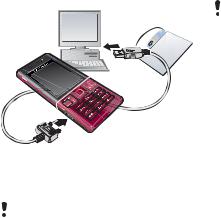
Using the USB cable
You can connect your phone to a computer with the USB cable to synchronize, transfer and back up phone content and use your phone as a modem. For more information, go to www.sonyericsson.com/support to read Getting started guides.
Before you use the USB cable
•See Required operating systems on page 22.
Only use a USB cable supported by your phone. Do not remove the USB cable from your phone or computer during transfer as this may corrupt the phone memory.
To disconnect the USB cable safely
1Right-click the removable disk icon in
Windows Explorer.
2 Select Eject.
3Disconnect the USB cable when there is a message saying it is safe to do so in the phone.
Do not copy the files immediately if you formatted the phone drive on the PC. In that case, remove the USB cable and restart the phone first.
Drag and drop content
You can drag and drop content between your phone memory and a computer in Microsoft Windows Explorer.
To drag and drop content
1Connect your phone to a computer using the USB cable.
2 Phone: Select Mass storage.
3Computer: Wait until the phone memory appear as external disks in
Windows Explorer.
4Drag and drop selected files between the phone and the computer.
Transferring and handling content |
23 |
This is the Internet version of the User guide. © Print only for private use.
